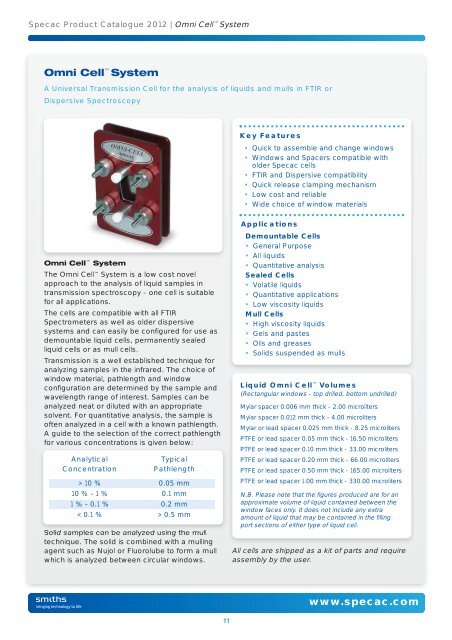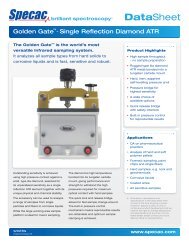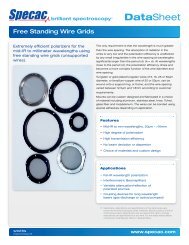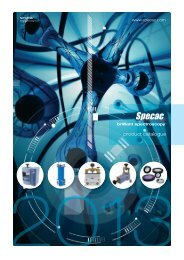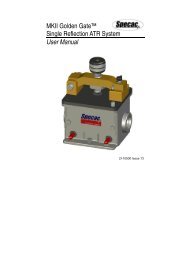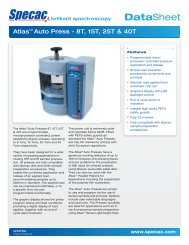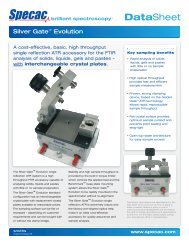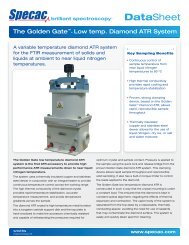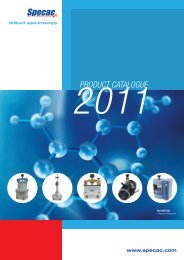2012 Product Catalogue
2012 Product Catalogue
2012 Product Catalogue
You also want an ePaper? Increase the reach of your titles
YUMPU automatically turns print PDFs into web optimized ePapers that Google loves.
Specac <strong>Product</strong> <strong>Catalogue</strong> <strong>2012</strong> | Omni Cell System<br />
Omni Cell System<br />
A Universal Transmission Cell for the analysis of liquids and mulls in FTIR or<br />
Dispersive Spectroscopy<br />
Key Features<br />
• Quick to assemble and change windows<br />
• Windows and Spacers compatible with<br />
older Specac cells<br />
• FTIR and Dispersive compatibility<br />
• Quick release clamping mechanism<br />
• Low cost and reliable<br />
• Wide choice of window materials<br />
Omni Cell System<br />
The Omni Cell System is a low cost novel<br />
approach to the analysis of liquid samples in<br />
transmission spectroscopy - one cell is suitable<br />
for all applications.<br />
The cells are compatible with all FTIR<br />
Spectrometers as well as older dispersive<br />
systems and can easily be configured for use as<br />
demountable liquid cells, permanently sealed<br />
liquid cells or as mull cells.<br />
Transmission is a well established technique for<br />
analyzing samples in the infrared. The choice of<br />
window material, pathlength and window<br />
configuration are determined by the sample and<br />
wavelength range of interest. Samples can be<br />
analyzed neat or diluted with an appropriate<br />
solvent. For quantitative analysis, the sample is<br />
often analyzed in a cell with a known pathlength.<br />
A guide to the selection of the correct pathlength<br />
for various concentrations is given below:<br />
Analytical<br />
Concentration<br />
> 10 %<br />
10 % – 1 %<br />
1 % – 0.1 %<br />
< 0.1 %<br />
Typical<br />
Pathlength<br />
0.05 mm<br />
0.1 mm<br />
0.2 mm<br />
> 0.5 mm<br />
Solid samples can be analyzed using the mull<br />
technique. The solid is combined with a mulling<br />
agent such as Nujol or Fluorolube to form a mull<br />
which is analyzed between circular windows.<br />
Applications<br />
Demountable Cells<br />
• General Purpose<br />
• All liquids<br />
• Quantitative analysis<br />
Sealed Cells<br />
• Volatile liquids<br />
• Quantitative applications<br />
• Low viscosity liquids<br />
Mull Cells<br />
• High viscosity liquids<br />
• Gels and pastes<br />
• Oils and greases<br />
• Solids suspended as mulls<br />
Liquid Omni Cell Volumes<br />
(Rectangular windows - top drilled, bottom undrilled)<br />
Mylar spacer 0.006 mm thick - 2.00 microliters<br />
Mylar spacer 0.012 mm thick - 4.00 microliters<br />
Mylar or lead spacer 0.025 mm thick - 8.25 microliters<br />
PTFE or lead spacer 0.05 mm thick - 16.50 microliters<br />
PTFE or lead spacer 0.10 mm thick - 33.00 microliters<br />
PTFE or lead spacer 0.20 mm thick - 66.00 microliters<br />
PTFE or lead spacer 0.50 mm thick - 165.00 microliters<br />
PTFE or lead spacer 1.00 mm thick - 330.00 microliters<br />
N.B. Please note that the figures produced are for an<br />
approximate volume of liquid contained between the<br />
window faces only. It does not include any extra<br />
amount of liquid that may be contained in the filling<br />
port sections of either type of liquid cell.<br />
All cells are shipped as a kit of parts and require<br />
assembly by the user.<br />
www.specac.com<br />
11


